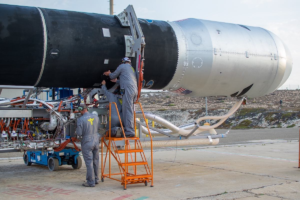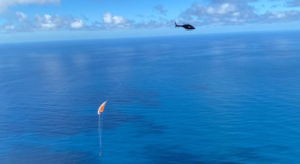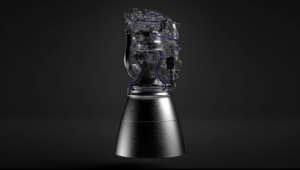
New Glenn Flight Hardware Is On The Launchpad!
In the timespan of about 24 hours, we just got more information on New Glenn and its first launch than practically the entirety of this rocket’s program. Right now New Glenn hardware is vertical on the launchpad including its booster which has been confirmed as flight hardware. This comes in addition to new info on its landing barge, maiden flight profile, plans to launch twice this year, and much more. Here I will go more in-depth into the recent rollout, all the new insights, what to expect in the coming months, and more.
New Glenn Is Vertical
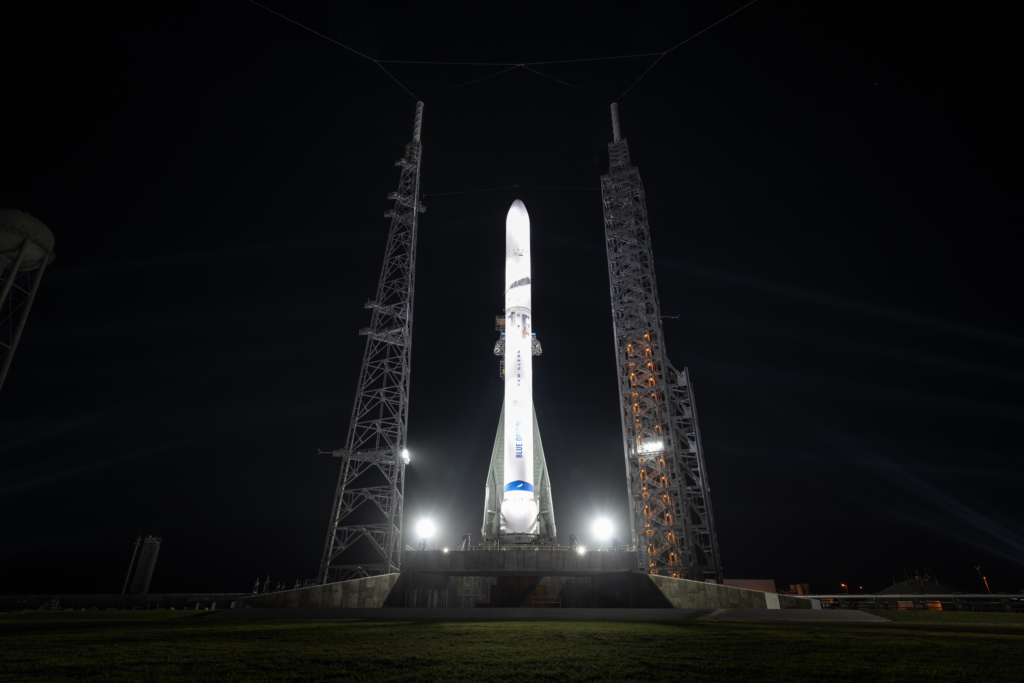
Starting yesterday afternoon, the company tweeted saying, “New Glenn, meet your launch pad. Our pathfinder vehicle is rolling out and upending soon for the first time to undergo a series of tanking and mechanical system tests.” This included images showing the full rocket, fairings included, headed to the pad. While they mention this vehicle is a pathfinder, it’s very different from the structural article we have seen recently. Both the first and second stages of this specific vehicle which is now vertical on the pad are filled with tanks and very capable. In another quote, Blue Origin said, “The rocket will remain vertical for at least a week for a series of tests in preparation for its first launch later this year.”
They also confirmed that the first stage is not just for testing, but will eventually be used on an actual New Glenn launch attempt. Currently, this stage is still missing some important features such as landing legs, strakes, and fins at the top. In a new interview with Allison Caron, senior director for launch facility development at Blue Origin, we learned that this first stage is also missing its 7 BE-4 engines. In recent images shown by the company the bottom of the booster was hidden by a cover which made it unclear whether or not the engines were installed. We now know the 7 engines for the hot fire are completing qualification testing at Blue Origin’s West Texas facility. Regarding the upcoming tests expected to happen in the next few days, they don’t need the engines or other missing hardware on the booster.
They will be completing an Integrated Tanking Test (ITT). In this case, the booster will be filled with liquid nitrogen, rather than liquid oxygen and liquefied natural gas. In an interview, the senior vice president for New Glenn clarified, “We made the decision to not put the engines on because it’s not part of the test. We’ll fill the tank up, make sure everything works with the fluids systems. It’s an integrated vehicle test, but it’s not firing the engine” he said.
Once this Integrated Tanking Test is complete, assuming the results are promising, the next step is a hot fire which the company is planning in only a few months. After the test, the first stage will be outfitted with an aft structure and the BE-4 engines, mated with a new upper stage, and then returned to the launchpad this summer for an actual hot fire. Jarrett Jones, the senior vice president expects to be ready to launch the first New Glenn vehicle shortly thereafter.
In terms of the first flight, not only is it planned to happen sooner than expected but new details regarding its flight profile were revealed. Back in 2022 Blue Origin changed its mind on the recovery vessel and scrapped a ship they originally planned to alter and use as a downrange landing platform. Soon after it was announced that they instead would be using a barge similar to SpaceX. “This is easier to operate and this is all about costs for us and lowering the cost of access to space. The barge was along the line of doing that,” Jones said. He then mentioned, “The landing barge will be ready soon.” Up until now, we haven’t heard practically anything about the barge and its progress. It was originally assumed that Blue Origin might not attempt to land the booster on the first flight but this also isn’t the case.
He disclosed that the company will be attempting to land the New Glenn booster downrange on a barge starting with the first flight. He was quoted saying, “That sounds aggressive, but it’s not. Think about how many times we’ve landed New Shepard right on the dime. All of the avionics systems, flight systems and everything that we’ve learned, we’ve transferred over—even the people have all come to work for New Glenn—and so I feel pretty confident” he said. While very ambitious, the company seems to think the first launch and its various operations all all well within reach. Based on everything said, it sounds like a launch in late summer is what the company is aiming for. If that wasn’t enough, in another quote he said, “We’re launching this year. It’s happening. Our plan is to launch twice this year.”
More Stages In Production
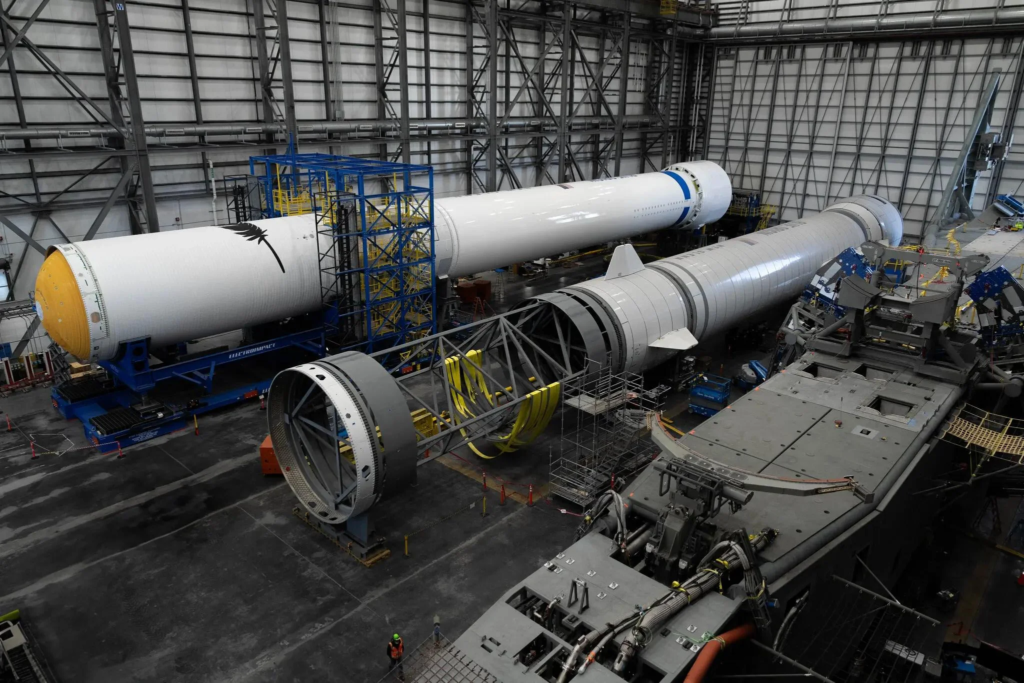
The New Glenn fleet is set to start with the production of 4 boosters. In addition, it was confirmed that right now the company has three complete second stages with another 3 in production. In order to support reusability, they are building a booster refurbishment facility about a mile away from LC-36 on Central Control Road. Initial booster refurbishment will take place at the SLC-36 Integration Facility. Jones was quoted saying, “We’ve designed and planned everything to fly within 30 days, but obviously we’ll have to wait for the first flight to determine how quickly we turn around. From the landing, to the gears and the avionics, the total system has been purpose-built for reusability” he said. In other words, they are planning to land a booster and have it ready for the next flight in only 30 days.
They also mentioned that the second stage will begin as expendable which hints at possible future plans to make it reusable as well. He mentioned, “We are really gaining the bucks on cost reduction by being able to produce second stages and fairings [in-house], but that’s why we’re always looking at engineering ways to not have to expend those things as well.” Jones, the senior vice president for New Glenn, believes they are creating the equipment to support 24 New Glenn launches a year and possibly even more in the future.
However, before all those launches can happen, they first need to successfully complete initial testing. Focusing back on the vertical New Glenn, the company shared more information about what exactly is the plan. In a statement, they said, “Everything on the pad is real New Glenn hardware. The upending is one in a series of major manufacturing and integrated test milestones in preparation for New Glenn’s first launch later this year. The test campaign enables our teams to practice, validate, and increase proficiency in vehicle integration, transport, ground support, and launch operations. These tests do not require engines, which are hotfiring at the historic 4670 Test Stand in Huntsville and Launch Site One in West Texas” they said.
They pointed out that “The journey to the pad began in December when New Glenn’s first-stage modules were transported from our factory to the Integration Facility nine miles away. The tests will conclude in the coming weeks following several demonstrations of cryogenic fluid loading, pressure control, and the vehicle’s venting systems. Our launch pad and ground systems are complete and will be activated for the first time during the test campaign” they said.
Standing at 320 feet, or around 98 meters tall, New Glenn vertical on the pad is quite the spectacle. Some of the images provided really put the heavy-lift rocket’s size into perspective. With everything that we’ve learned in the last day, the question becomes how likely are the time estimates provided by the company. While the testing that’s going on right now is significant, the hot fire they believe will happen in a few months will be a major milestone. Based on current testing and BE-4s progress, the hot fire timeline seems realistic.
BE-4 is one of the most powerful liquefied natural gas (LNG) fueled rocket engines ever developed. In relation to the reuse plans, they point out that BE-4 was designed from the beginning to be a medium-performing version of a high-performance architecture. A conscious design choice made to lower development risk while attempting to meet performance, schedule, and reusability requirements.
The company is quite confident in the design thanks to the recent ULA Vulcan launch. That rocket used two BE-4 engines and for the first time lifted off proving the engine’s capability. We have also seen a ramp-up in engine production which correlates to all the boosters and demand they have. All of which support a timely delivery of the engines and upcoming static fire.
Other goals such as landing the booster on the first flight are even more ambitious. On the first fight, the sea-based platform will be located roughly 620 miles (1,000 km) downrange. After upper-stage separation, the booster will begin its journey back toward Earth. At the top, four actuated aerodynamic control surfaces help attitude adjustment during the first stage’s descent and landing. This in addition to two wing-like strakes provide lift and cross-range. The company mentioned that they had a lot of experience with New Shepard which gave them confidence in landing the first try with New Glenn. While it definitely helps, these are massively different rockets. A maiden flight first-try landing would be massively impressive. Something we could see attempted later this year.
Conclusion
Blue Origin just released a bunch of new information on New Glenn and what to expect throughout this year. This included tanking tests going on right now, a nearly complete barge, engine development, stage production, and much more. We will have to wait and see how it progresses and the impact it has on the space industry.

